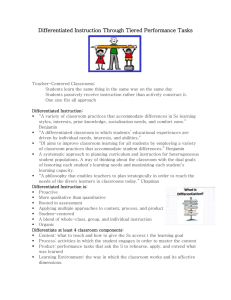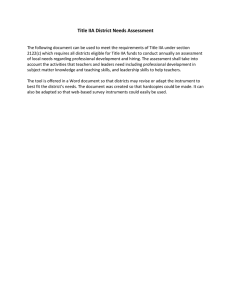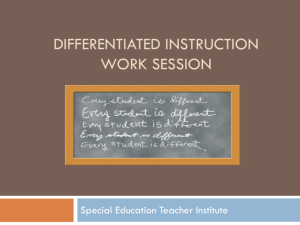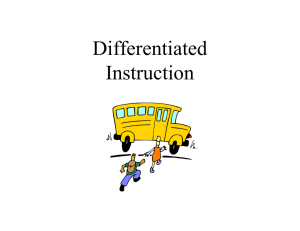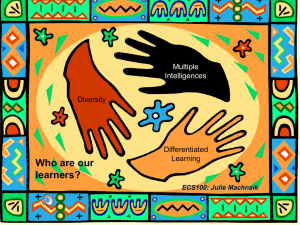File
advertisement
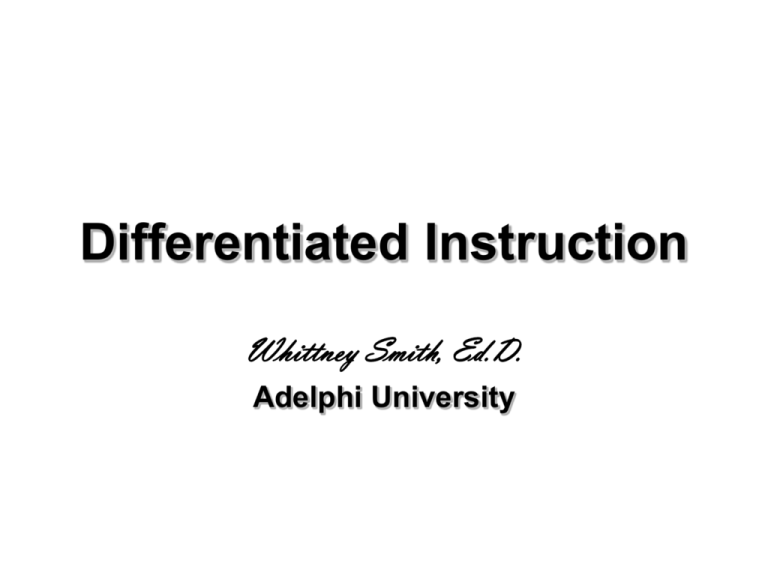
Differentiated Instruction Whittney Smith, Ed.D. Adelphi University Daniel Willingham Why Don’t Students Like School? • “The first thing to know is that everyone likes to learn.” • “There is a sense of satisfaction, of fulfillment, in successful thinking” But it’s not fun to try to learn something that’s too hard. • “Working on a problem with no sense that you’re making progress is not pleasurable… in fact, it’s frustrating.” • “Working on a problem that’s too easy is no fun either. It’s boring.” • “What people enjoy is working on problems that are the right level of difficulty.” • “The problem must be easy enough to be solved yet difficult enough to take some mental effort.” He calls this the “sweet spot” of difficulty. What is Differentiated Instruction? • Differentiated Instruction (DI) addresses each student’s growth and individual success by meeting them where they are, and assisting in the learning process. • Simply put… A teacher's reacting responsively to a learner's needs Differentiated Instruction IS… • Student Centered • Tiered • Balance of WholeClass, Group and Individual Instruction • Flexible and Responsive • Heterogeneous • PROACTIVE! IS NOT… • One-Size-Fits-All Instruction • Homogenous all the time • Special Education or ESL • “Tailoring the Same Suit of Clothes” Content • Determine the Ability Levels of Your Students – Survey Past Records, Look at their past educational history • Align Tasks and Objectives to Learning Goals (Begin with the end in mind!) • Survey Student Interests – Interest Inventories, Interview/Conference, Respond to OpenEnded Questionnaire with Questions • What are Your Students’ Learning Styles? • What are Your Student’s Preferences and Motivators? • Instruction is based on Essential Questions / Understandings • Brain-Based Research • Know Your Students! Content • • • • • • Project-Based Learning Group learning/discussions Case study, Lab activity, Debate Student-created videos Peer review of work “Menus” Instructional Strategies • Flexible Grouping is Consistently Used – Groupings are Not Fixed, and Should Be Dynamic in Process – Teach Whole Class Introductory Discussions, then Follow with Small Group (or) Pair Work. • • • • Direct Instruction Inquiry-Based Learning Cooperative Learning Classroom Management Benefits Students and Teachers – Organization & Routines Instructional Strategies • Who? – Struggling Learners • Modeling / Direct Instruction Needed • Review with Visuals Needed • Will Complete Graphic Organizers – On-Grade Learners • Can complete on-grade assignments • Less review needed • Can create their own Graphic Organizers – Advanced Learners • Can work independently and interpret information on their own • Can work with ideas and expand concepts Instructional Strategies • What? –Backward Design –Tiered Lessons –Choice Instructional Strategies • What? – Backward Design Goals & Objectives Assessment •Formative •Summative •Portfolio •Video Varied; Clear; With Passion Instructional Strategies • What? – Tiered Lessons “Tiered instruction is like a wedding cake; all one flavor; same color icing but multilayered.” - Carol Ann Tomlinson “Fair is not equal, fair is getting what you need (when you need it)” Instructional Strategies • What? – Choice © Tomlinson ,2001 Products (Assessments) • Initial & Ongoing Assessment of Student Readiness & Growth are Essential (Formative and Summative) • Authentic Assessment • Students are Active & Responsible Explorers • High Expectations with Varied Requirements for Student Responses • Consider each Student’s Multiple Intelligences & Learning Styles Based on Outcomes Classroom • How the Environment is Organized? – Groupings – Collaborative / Quiet Spaces – Routines – Procedures – Student Ownership vs. Buy-in Classroom • Flexible Grouping Options Learning Cycle & Decision Factors Used in Planning and Implementing Differentiated Instruction



